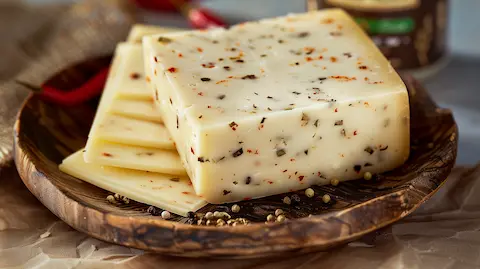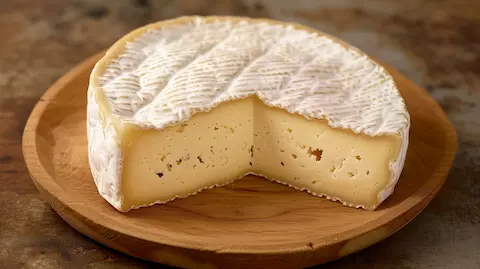Menonita Cheese
Menonita is a smooth, mild cheese that originates from the Mennonite communities of northern Mexico. Known for its pale yellow hue and semi-soft texture, Menonita often bears a resemblance to cheddar but carries a gentler, buttery flavor. This cheese is traditionally crafted from cow's milk and is celebrated for its melting qualities, making it a favorite in both hot dishes and as a stand-alone snack. Menonita's history is intertwined with the Mennonite people, whose European roots and migration to Mexico have influenced its production methods and contributed to its regional popularity.
How is Menonita Made?
Menonita cheese is made by heating pasteurized cow's milk to a specific temperature before adding a culture that starts the fermentation process. Rennet is then introduced to coagulate the milk into curds and whey. The curds are cut, allowing the whey to drain away, and then pressed into molds to form the cheese blocks. These blocks are brined to infuse them with flavor and to act as a preservative. Finally, the cheese is aged in controlled environments to develop its texture and taste before being ready for consumption.
Here is a detailed breakdown of the production process:
Menonita Cheese Production Process
| Step | Description | Ingredients | Temperature | Duration |
|---|---|---|---|---|
| 1. Pasteurization | Milk is heated to remove pathogens. | Cow's milk | 72°C (161°F) | 15 seconds |
| 2. Fermentation | Culture is added to milk to start fermentation. | Starter culture | 32°C (90°F) | 1-2 hours |
| 3. Coagulation | Rennet is added to form curds and whey. | Rennet | 32°C (90°F) | 30-40 minutes |
| 4. Curd Treatment | Curds are cut and whey is drained off. | Room temperature | Varies | |
| 5. Pressing | Curds are pressed into molds to form cheese blocks. | Room temperature | 2-4 hours | |
| 6. Brining | Blocks are submerged in brine to season and preserve. | Salt, Water | Brine temperature | 12-24 hours |
| 7. Aging | Cheese is aged to develop flavor and texture. | 10-16°C (50-60°F) | 1-2 months |
What does Menonita taste like?
menonita tastes like a milder version of cheddar with a creamy and buttery profile. Its flavor is subtle yet distinctive, offering a pleasant balance of nuttiness and tanginess that is neither too sharp nor too bland. This cheese has a smooth texture that melts effortlessly, making it a versatile choice for a variety of dishes.
Menonita Cheese Profile
Exploring the characteristics of Menonita cheese reveals a profile rich with cultural heritage and sensory appeal. Here are some key facts about this delightful cheese:
- Made from: Cow's milk
- Country of origin: Mexico
- Region: Chihuahua and other northern regions
- Family: Semi-soft cheeses
- Type: Semi-soft
- Texture: Creamy and smooth
- Rind: Natural or waxed
- Colour: Pale yellow
- Aroma: Mild, with a hint of buttery notes
- Vegetarian: No, due to the use of animal rennet
- Producers: Small-scale Mennonite farms and larger dairy operations
Where does Menonita cheese come from?
Menonita cheese comes from the Mennonite communities of northern Mexico, particularly in the state of Chihuahua. These communities, with their European cheesemaking heritage, have been producing Menonita since their arrival in the early 20th century, blending traditional techniques with the local Mexican culture to create this unique cheese.
How to Store Menonita?
Proper storage of Menonita is key to preserving its delightful flavor and creamy texture. In the refrigerator, Menonita should be wrapped in wax or parchment paper, which allows the cheese to breathe and maintain its moisture without becoming too dry or absorbing other odors. For extended freshness, an additional layer of plastic wrap can be used to protect the cheese from air exposure.
- Initial Wrapping: Wrap the Menonita in wax or parchment paper.
- Additional Layer: Cover the first layer with plastic wrap for extra protection.
- Refrigeration: Store the wrapped cheese in the vegetable compartment of the refrigerator, which typically has a consistent temperature.
- Inspection: Check the cheese regularly for any signs of spoilage or mold and change the wrapping if it becomes damp or soiled.
How long does Menonita cheese last?
Menonita cheese's shelf life depends on how it is stored. When kept in the refrigerator, it can remain fresh for several weeks. Freezing Menonita is possible, but it's important to note that while freezing can extend its shelf life, it may also affect the cheese's texture and flavor. Once thawed, Menonita may become crumblier and less creamy, though it will still be suitable for cooking or melting.
| Storage Location | Shelf Life | Texture After Thawing | Taste After Thawing |
|---|---|---|---|
| Outside | 2-4 hours | ||
| Fridge | 2-3 weeks | ||
| Freezer | Up to 2 months | Crumblier | Less creamy |
Can You Freeze Menonita?
Yes, you can freeze Menonita cheese. This method can prolong its shelf life, making it a convenient option for those who may not consume it immediately. However, freezing Menonita may result in changes to its texture, often leading to a crumblier consistency upon thawing. While the taste remains relatively unaffected, the altered texture is something to consider, especially if you plan to enjoy the cheese on its own rather than melted in a dish.
Alternatives to Menonita Cheese
When Menonita cheese is not available, or if you're looking to explore different flavors and textures, there are several suitable substitutes that can be used in its place. These alternatives offer a range of flavors from mild to sharp and can complement various dishes in a manner similar to Menonita. The table below outlines some of the best substitutes, detailing their origins, characteristics, and culinary uses to guide you in making an informed choice.
Menonita Cheese Substitutes
| Cheese | Origin | Milk Source | Texture | Flavor | Best Used In |
|---|---|---|---|---|---|
| Mild Cheddar | England | Cow | Semi-soft to firm | Mild, creamy | Grilled cheese, casseroles |
| Monterey Jack | United States | Cow | Semi-soft | Mild, buttery | Quesadillas, burgers |
| Edam | Netherlands | Cow | Semi-hard | Mild, nutty | Cheese platters, sandwiches |
| Gouda | Netherlands | Cow | Semi-soft to hard | Rich, caramel-like | Mac and cheese, soups |
| Colby | United States | Cow | Semi-soft | Mild, creamy | Snacking, melting in dishes |
| Havarti | Denmark | Cow | Semi-soft | Buttery, slightly sweet | Cheese boards, sandwiches |
Menonita Popular Comparison
Menonita is frequently compared to Cheddar, particularly mild Cheddar, due to their similar textures and melting properties. While both cheeses are excellent for cooking, Menonita is typically milder and creamier, offering a subtle contrast to Cheddar's sharper and more pronounced flavor.
How to Use Menonita
Menonita's exceptional melting qualities make it ideal for incorporating into hot dishes where it can add a rich, creamy texture. To cut Menonita for melting or serving, a sharp knife is recommended to create even slices or shreds, depending on the intended use. The cheese's versatility extends beyond melting; it can be cubed for salads, grated over dishes for a flavor boost, or simply enjoyed on its own.
| Use | Description |
|---|---|
| Melting | Perfect for quesadillas, enchiladas, or as a topping for chili. |
| Cubing | Add to salads or skewers for a burst of creamy flavor. |
| Grating | Sprinkle over tacos, soups, or baked potatoes. |
| Serving | Offer as part of a cheese board or as a simple snack with crackers. |
| Slicing | Create even slices for sandwiches or burgers. |
How to Serve Menonita
Menonita shines when served at room temperature, allowing its full flavor to be appreciated. On a cheese board, it pairs beautifully with fruits like grapes and figs, as well as with a variety of nuts and a selection of bread or crackers. For a touch of sweetness, consider adding a dollop of fruit preserves or honey to complement Menonita's buttery notes.
Recipes Using Menonita
Menonita's creamy consistency and mild flavor profile make it an excellent candidate for a wide range of recipes. Its ability to melt smoothly lends itself to dishes that require a gooey, cheesy component, while its subtle taste complements rather than overpowers other ingredients.
- Enchiladas: Menonita's melting quality makes it perfect for a gooey filling or topping.
- Chiles Rellenos: The cheese's mildness balances the spice of the peppers.
- Queso Fundido: Menonita blends well with other cheeses for a rich, creamy dip.
- Arroz Con Queso: Adds a comforting, creamy texture to this classic rice dish.
- Cheese Tamales: Its smooth melt is ideal for the steamy interior of a tamale.
Menonita Nutrition Data
There are 357 calories in Menonita cheese per 100g. Menonita is a source of protein and calcium, but it also contains a significant amount of fat, which should be considered within a balanced diet.
| Nutrient | Amount per 100g | % Daily Value* |
|---|---|---|
| Calories | 357 | - |
| Total Fat | 28g | 43% |
| Saturated Fat | 18g | 90% |
| Cholesterol | 75mg | 25% |
| Sodium | 620mg | 26% |
| Total Carbohydrates | 1.3g | <1% |
| Dietary Fiber | 0g | 0% |
| Sugars | 0.5g | - |
| Protein | 22g | 44% |
| Calcium | 600mg | 60% |
*Percent Daily Values are based on a 2,000 calorie diet. Your daily values may be higher or lower depending on your calorie needs.
What's Next? WhatCheese Insights
If you are keen to indulge in the creamy delight of Menonita cheese, you'll find it available at specialty cheese shops and Latin American markets, particularly those that focus on Mexican cuisine. For convenience, online cheese retailers also stock Menonita and can deliver it right to your door. It's a cheese that's gaining traction among cheese aficionados, so keep an eye out for it at your local farmers' markets as well.
If you are an enthusiast eager to explore your appreciation for Menonita, attending cheese and wine pairing events is a splendid idea. These gatherings are not only educational but also a sensory pleasure, offering a platform to experience how Menonita's mild and creamy flavor profiles pair with various wines. Look for events at local culinary schools, cheese shops, or wine bars, which often host such tastings. These venues provide a convivial atmosphere to learn, taste, and celebrate the rich tapestry of cheese varieties, including the beloved Menonita.
For those who enjoy the semi-soft texture and versatility of Menonita, consider trying cheeses like fontina, Muenster, or young Provolone. These varieties share similar melting characteristics and are excellent in cooked dishes or simply savored on their own.

















